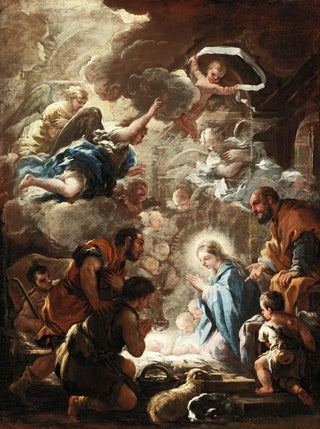Art print | Adoration of the shepherds - Luca Giordano


View from behind

Frame (optional)
The artwork "Adoration of the Shepherds" by Luca Giordano is a masterpiece that transports the viewer to the heart of a scene filled with devotion and tenderness. Created in the 17th century, this canvas depicts the sacred moment of the adoration of the Baby Jesus by shepherds, a recurring theme in Christian art that evokes the simplicity and humility of divine birth. Giordano, with his exceptional talent, manages to capture not only the instant but also the emotion that emanates from it. The soft light bathing the scene, the expressions of the characters, and the richness of details make this work a true invitation to contemplation and spirituality.
Style and uniqueness of the work
Luca Giordano's style is often characterized by dynamism and expressiveness, which manifest in the bold use of color and light. In "Adoration of the Shepherds," he employs striking contrasts to highlight the human figures and their interaction with the divine. The faces of the shepherds, filled with sincere fervor, are illuminated by a celestial light that seems to emanate from the Baby Jesus himself. Giordano excels in rendering textures, whether it is the drapery of clothing or the softness of the characters' skin. This attention to detail, combined with a harmonious composition, creates an atmosphere of intimacy and reverence that invites the viewer to share this sacred moment. The scene, although dynamic, retains a certain serenity, symbolizing the peace that the birth of Christ represents.
The artist and his influence
Luca Giordano, nicknamed "Luca fa presto" due to his speed of execution, is one of the emblematic figures of Neapolitan Baroque. Trained in the shadow of the great masters, he developed a personal style that combines tradition with innovation. His influence extends well beyond his era, affecting many artists inspired by his ability to animate canvases through movement and light. Giordano managed to incorporate elements of Venetian painting while maintaining a more dramatic approach.

Matte finish

View from behind

Frame (optional)
The artwork "Adoration of the Shepherds" by Luca Giordano is a masterpiece that transports the viewer to the heart of a scene filled with devotion and tenderness. Created in the 17th century, this canvas depicts the sacred moment of the adoration of the Baby Jesus by shepherds, a recurring theme in Christian art that evokes the simplicity and humility of divine birth. Giordano, with his exceptional talent, manages to capture not only the instant but also the emotion that emanates from it. The soft light bathing the scene, the expressions of the characters, and the richness of details make this work a true invitation to contemplation and spirituality.
Style and uniqueness of the work
Luca Giordano's style is often characterized by dynamism and expressiveness, which manifest in the bold use of color and light. In "Adoration of the Shepherds," he employs striking contrasts to highlight the human figures and their interaction with the divine. The faces of the shepherds, filled with sincere fervor, are illuminated by a celestial light that seems to emanate from the Baby Jesus himself. Giordano excels in rendering textures, whether it is the drapery of clothing or the softness of the characters' skin. This attention to detail, combined with a harmonious composition, creates an atmosphere of intimacy and reverence that invites the viewer to share this sacred moment. The scene, although dynamic, retains a certain serenity, symbolizing the peace that the birth of Christ represents.
The artist and his influence
Luca Giordano, nicknamed "Luca fa presto" due to his speed of execution, is one of the emblematic figures of Neapolitan Baroque. Trained in the shadow of the great masters, he developed a personal style that combines tradition with innovation. His influence extends well beyond his era, affecting many artists inspired by his ability to animate canvases through movement and light. Giordano managed to incorporate elements of Venetian painting while maintaining a more dramatic approach.






